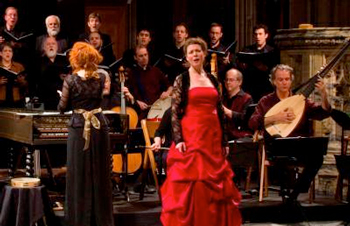by Mike Telin

A colorful band of bagpipes, flutes, strings, and Celtic harp will join Apollo’s Singers. The performances also mark the return of three of Apollo’s Fire’s favorite guest artists — Canadian soprano Meredith Hall, British baroque guitarist and step dancer Steve Player and hammered dulcimer virtuoso Tina Bergmann.
ClevelandClassical.com reviewer William Fazekas called Sacrum Mysterium “…a careful balance of the familiar and the exotic [that includes] traditional Christmas songs [such as] The Coventry Carol, [and] early music standards” such as the 17th century Scottish carol Come, My Children Dere, and the instrumental numbers Scotch Cap and Wild Geese.” Fazekas also wrote, “Jeanette Sorrell has assembled [a] holiday offering [that is] a little of this, a little of that, carefully arranged and impeccably performed to create a truly satisfying evening’s entertainment.”
Sacrum Mysterium is an international collaboration between Apollo’s Fire and Ensemble La Nef of Montréal, directed by Sylvain Bergeron, who is also the co-creator of the project. Jeannette Sorrell originally conceived the idea for this program back in 2009, following a visit to Montréal where she met Bergeron and heard his ensemble perform live.
“Meredith and Sylvain had already done a beautiful Scottish Christmas CD with the Gaelic title “Oikan ains Bethlehem,” Sorrell said. “I took that CD home with me after hearing their lovely concert in Montréal. The opening track seemed to be calling to me, wanting to be a procession in a cathedral. And from there, my imagination took over, and a program blending a Scottish medieval Vespers service with pagan/folk elements came into my head immediately. So I called up Sylvain and Meredith and convinced them to plan this with me.”
Sorrell said the biggest challenge in bringing the idea to reality was the lack of surviving sacred Renaissance and Baroque music from Ireland and Scotland. During a 2011 interview, Sorrell told ClevelandClassical.com, “I’m quite lucky because just this year, a scholarly publisher in Scotland came out with an edition of the 13th century Vespers of St. Kentigern (patron saint of Glasgow). If they had not brought it out this year I don’t know what I would have done. I did a lot of research and consulted with a scholar at the University of Edinburgh, because I simply could not find any 17th or 18th century church music from Scotland or Ireland.”

The program is divided into three sets and Sorrell said that most of planning conversations centered on how to shape each set. “Most of the pieces are only about three minutes long. So we did need to group them in order to create a little bit longer musical journey for people.” She says that they even went as far as to create their own inside names for each set: “one was called happy, one was called intimate and another was called dark. So we grouped the pieces together in that way. Many of them are beloved carols and people will recognize Lully, Lullay and even if people are not aware of the title they will recognize Noël Nouvelet. So there are carols that are somewhat familiar, and then others that do sound Irish and Scottish, and they have a lovely haunting quality to them.”
Sorrell thinks the program is an exciting and emotional journey for people, beginning with a procession that explodes into a wild pagan section with dancing. “I think it will touch people on an emotional level because it does allow us to tap into that universal connection that we have with music and art and with each other.”
Published on ClevelandClassical.com November 26, 2013
Click here for a printable version of this article.

